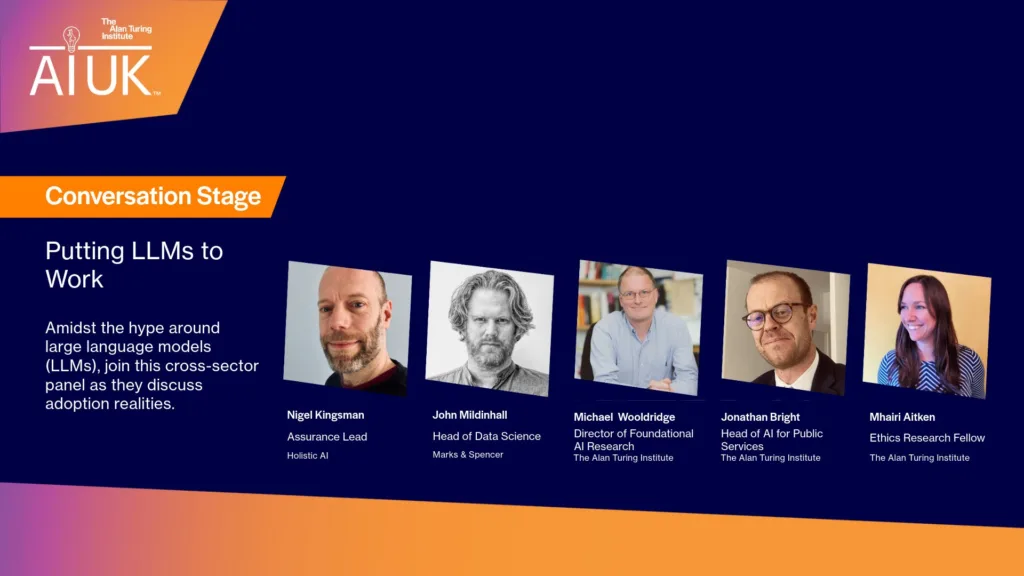
Want to use AI in business? Then think mundane tasks not revolution
A panel of experts at the Turing Institute’s AI UK conference in London believe it’s time to put LLMs to work. Nicole Kobie was there to give us this report
Forget new products, organisational upheaval or revolution in the boardroom when it comes to using generative AI and large language models (LLMs). Instead, it’s time to get excited about mundane tasks — and get rid of them.
That’s according to a panel of experts speaking at the Turing Institute’s AI UK conference in London.

The past 18 months have seen a wave of hype around generative AI, noted Mhairi Aitken, an ethics fellow at Turing Institute, and that enthusiasm fuelled experimentation — some of which perhaps shouldn’t have happened.
But now that the hype is calming down, we’re able to have “realistic discussions” about how these tools can — and should — be used. “That’s a really good place to be in, and we can have good discussions about what these systems do well and what they can deliver.”
She adds: “Let’s get excited about mundane tasks!”
Cutting bureaucracy
Jonathan Bright, Head of AI Public Services at the Turing Institute, agrees with her — especially when it comes to mundane tasks. “I think that’s where the opportunity is for the public sector.”
Bright says his research suggests doctors spend 25% of their week on bureaucracy, a figure echoed across the public sector in social care, education and the civil service. He points to automatic transcription of notes after a meeting — a technology that already exists — and says it can save GPs, social workers and more hours a week.
Meanwhile, LLMs can help with writing reports and developing lesson plans.
No wonder then, Bright says, that three in ten teachers are already using generative AI, with similar levels seen in the NHS and policing — and much of it as bottom-up adoption, meaning front-line workers are making their own tools without involving developers.
“All of the technology to do that seems to more or less exist,” Bright says. “It’s a tantalising prospect to help these people — they got into these professions to help people, not to do bureaucracy, so we should free up their time.”
For that reason, he thinks some of the hype around LLMs and generative AI is justified: “You can see real use cases and that’s extremely exciting right now.”
Michael Wooldridge, Professor of Computer Science in the Department of Computer Science at the University of Oxford, and Director of Foundational Research at the Turing Institute, notes that the government is powered by a hundred thousand people doing routine intellectual tasks. “Helping them be more efficient and letting them focus on areas that need human insight… is extraordinarily relevant for the government,” he says.
And the theory is backed up by the figures. A study by the Turing Institute – announced today – reveals that 84% of repetitive transactions across 200 government services could be automated in the UK.
Given that the central government has more than a billion transactions with users each year, that could result in significant savings.
Related: What is Microsoft 365 Copilot? Guide by a Microsoft MVP | TechFinitive
Automating the private sector
Of course, bureaucracy exists beyond the world of public service. John Mildinhall is Head of Data Science at Marks and Spencer, where he’s building an army of chatbots.
At the moment, Mildinhall believes LLMs haven’t lived up to their potential. Quoting an online truism: “We thought LLMs were going to do tedious things for creative people, but it turns out they do creative things for tedious people.” But by refocusing on mundane tasks, he says, “I think it’s pretty tantalising what could be achieved”.
Mildinhall points to the use of LLMs to “glue together” the backend of systems and to clean data, but M&S is also using it to power dozens of chatbots for use inside the organisation. “We have to build a chatbot factory,” he says because it’s not clear which will be useful and which won’t.
One example is a store operating procedure bot. It’s an expert on more than 100 key documents for running a food store — how to refresh the nuts, ensure magazines aren’t out of date, and present the produce well. “The thing about that is there’s some key information that is life and death — you can go to prison for running a store incorrectly,” he says, for selling expired food or not properly managing allergens.
The chatbots don’t replace store-level experts. Instead, they’re a tool to better communicate to employees; and because the information is so important, Mildinhall notes it’s key to ensure the information is accurate.
Automation with purpose
Mildinhall warns that automation for the sake of it — or purely for the sake of cost-cutting — can lead to unexpected impacts. He points to the “doorman fallacy”, where automated doors rid the need to pay a salary to a person to open and close them — but that forgets that a doorman has a much wider remit, operating as security, customer service and more.
Indeed, one AI software vendor pitched to Marks and Spencer a tool to rid the company of writing a specific set of product reports that are written by junior members of staff. But Mildinhall notes that the aim of the task isn’t to have an “unending library of reports” but to train those newer employees, to get them to “think very deeply about what they’re doing”.
So even when it comes to mundane tasks, Mildinhall says, “we have to be careful what we’re trying to automate”.
Worth a read
NEXT UP

Slow buyers cause tech firms to rethink sales approaches as tough Q1 hits home
New research suggests tech sales were slow in Q1, with buyers of technology and professional services taking their time before committing to any solutions.

ByteDance says it has no plans to sell TikTok and refuses to bow to US pressure
ByteDance, the Chinese company that owns TikTok, stated that it “doesn’t have any plans to sell TikTok” on Toutiao, a social media platform that it also happens to own.

Solace Kidisil, Group COO of Nsano: “The difference between traditional finance and fintech is the questions we ask”
We interview Solace Kidisil, Group COO of Nsano, a fintech company from Ghana, offering digital payment solutions across Africa
